Acrylic Resin Market Size
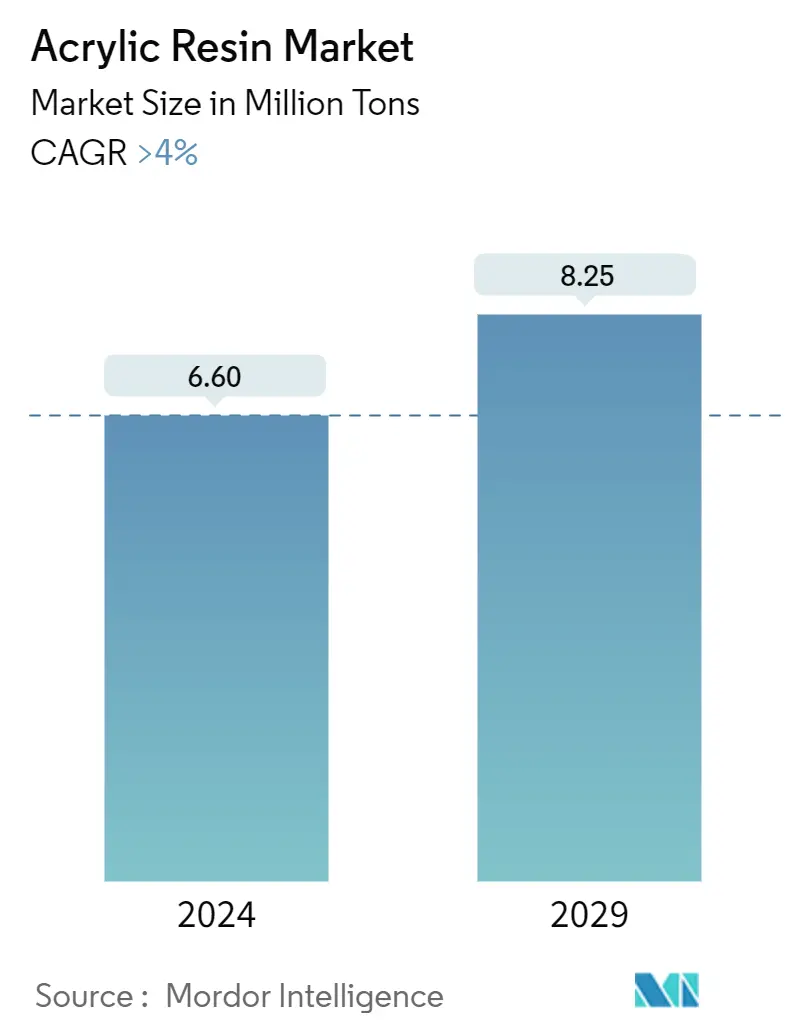
| Study Period | 2019-2029 |
| Market Volume (2024) | 6.60 Million tons |
| Market Volume (2029) | 8.25 Million tons |
| CAGR (2024 - 2029) | > 4.00 % |
| Fastest Growing Market | Asia Pacific |
| Largest Market | Asia Pacific |
| Market Concentration | Medium |
Major Players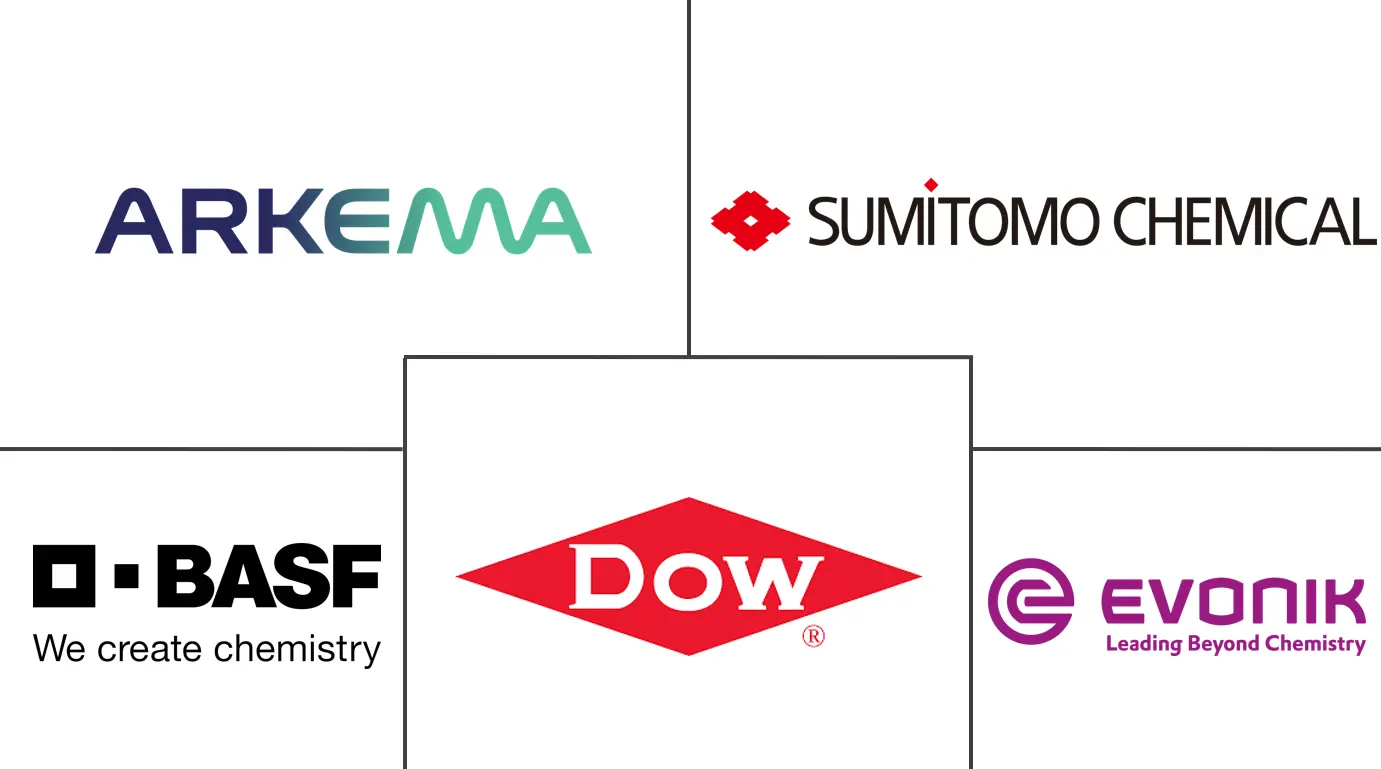
*Disclaimer: Major Players sorted in no particular order |
Acrylic Resin Market Analysis
The Acrylic Resin Market size is estimated at 6.60 Million tons in 2024, and is expected to reach 8.25 Million tons by 2029, growing at a CAGR of greater than 4% during the forecast period (2024-2029).
The COVID-19 pandemic affected several industries negatively. The lockdown in most regions caused disruptions in industrial as well as construction activities, and restrictions in freight transportation disturbed the supply chain. However, the conditions started recovering in 2021, restoring the market's growth trajectory.
- Growing construction projects in major economies in Asia-Pacific, and increasing usage in automotive applications are major factors driving the growth of the market studied.
- However, the environmental and health hazards associated with acrylic are likely to restrain the growth of the studied market.
- Nevertheless, research and development of bio-based resin will likely create lucrative growth opportunities for the global market.
- Asia-Pacific represents the largest market over the forecast period due to the increasing number of construction projects and infrastructure development.
Acrylic Resin Market Trends
Building and Construction Industry to Dominate the End-User Industry Segment
- Acrylic resin is used in building and construction to improve the sustainability, durability, and aesthetics of building materials and for moisture, corrosion, temperature extremes, and weathering resistance of architectural coatings.
- Acrylic resin is also used in paints and coatings applications to provide adhesion over various substrates, superior film resistance properties, flexibility, and durability, and enhance the hiding capacity of paints and coatings.
- The growing infrastructure needs across the globe are adding more value to the acrylic resin market. According to the US Census Bureau, in the past 5 years, from 2018 to 2022, the total value of construction in the United States increased by almost 40%, with residential construction accounting for almost more than a 60% increase in the total value of construction.
- The total value of residential construction in 2022 was USD 927 billion, an increase of 14.6% over 2021. The total value of non-residential construction in 2022 was USD 921 billion, an increase of 9% over 2021.
- According to Eurostat, the annual average production in construction for 2022 increased by 2.6% in the European Union compared with 2021. The highest increase in construction activities was recorded in Slovenia (+74.5%), Romania (+18.4%), and the Netherlands (+4.9%).
- Asia-Pacific is the largest construction market in the world, with India and China leading the way in terms of construction value-added and new projects.
- According to the National Bureau of Statistics China, the value added of construction enterprises in China for 2022 was RMB 8.33 trillion (~USD 1.16 trillion), up by 5.5% over 2021.
- According to Invest India, FDI in the construction (infrastructure) activities in India totaled USD 29.6 billion between April 2000 and March 2023, which accounts for 4.67% of the FDI inflow.
- Looking at the growth in infrastructure in major economies across the globe, the demand for acrylic resin for paints, coatings, adhesives, and sealant applications in the construction industry will likely increase in the forecast period.
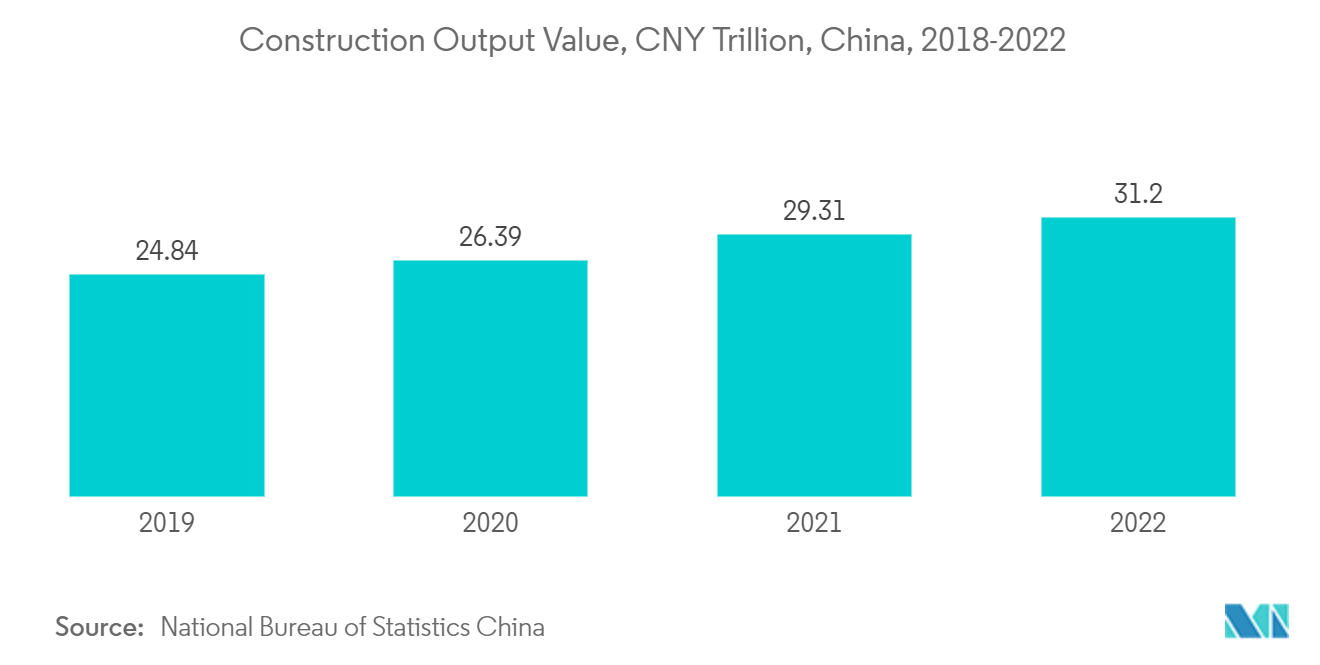
Asia-Pacific to Dominate the Market
- Asia-Pacific is the largest market and major demand driver for acrylic resin due to increasing consumption in construction, automobile, and other end-user industries.
- In major economies like China, India, and South Korea, construction is growing rapidly due to urbanization. The countries launched various residential construction projects in recent times.
- The Chinese government is focusing on boosting investments across the construction sector in the country to boost overall economic growth. For instance, according to the National Bureau of Statistics China, recent moves to increase financing for infrastructure construction include a USD 120 billion increase in the lending ratio of policy banks. The government is also considering allowing local governments to spend up to about USD 220 billion of the special bond quota through which local governments fund infrastructure construction.
- According to the Union Budget 2023, the Ministry of Finance, Government of India announced a capital investment of INR 10 Lakh Crore (~USD 120.87 billion) for infrastructure, a 33% increase in capital Investment Outlay. The outlay for PM Awas Yojana increased by 66% to over INR 79,000 crore (~USD 9.54 billion).
- Moreover, under the Urban Infrastructure Development Fund, the government announced an outlay of INR 10,000 crore (~USD 1.2 billion) per year to create urban infrastructure in tier 2 & 3 cities across the country.
- In South Korea, the expansion of smart cities is a major focus area for the country. The Smart City, Solution Expansion Project, is implemented in South Korean cities to improve service conditions and minimize the digital divide by enabling smaller cities with a robust infrastructure. In 2023, a total of 23 local governments applied for the smart city solution expansion project, out of which 8 locations were selected.
- Moreover, the Asia-Pacific region is home to some of the world’s most valuable vehicle manufacturers. Developing countries such as China, India, Japan, and South Korea are working hard to strengthen the manufacturing base and develop efficient supply chains for greater profitability. According to the Organisation Internationale des Constructeurs d’Automobiles(OICA), in 2022, around 50 million vehicles were produced across the Asia-Pacific. It witnessed a growth rate of 7% compared to 46.7 million vehicles in 2021, thereby indicating an increased demand for ultra-high molecular weight polyethylene from the automotive industry. In 2022, around 42 million passenger cars were manufactured in Asia-Pacific, up nearly 11% compared to 2021.
- According to the China Association of Automobile Manufacturers (CAAM), China holds the largest automotive production base in the world, with a total vehicle production of 27 million units in 2022. It registered an increase of 3.4 % compared to 26 million units produced in 2021.
- Furthermore, the demand for electronics products in the Asia-Pacific region mainly comes from China, India, and Japan. As per the Japan Electronics and Information Technology Industries Association (JEITA), the Asia Pacific production by Japanese Electronics and IT Companies is likely to reach JPY 40,759.9 billion (~USD 312.15 billion) by the end of 2023, witnessing a growth rate of 3% year-on-year.
- The demand for acrylic resin is expected to grow significantly for the studied market by looking at the positive growth trends in the major end-user industry segments.
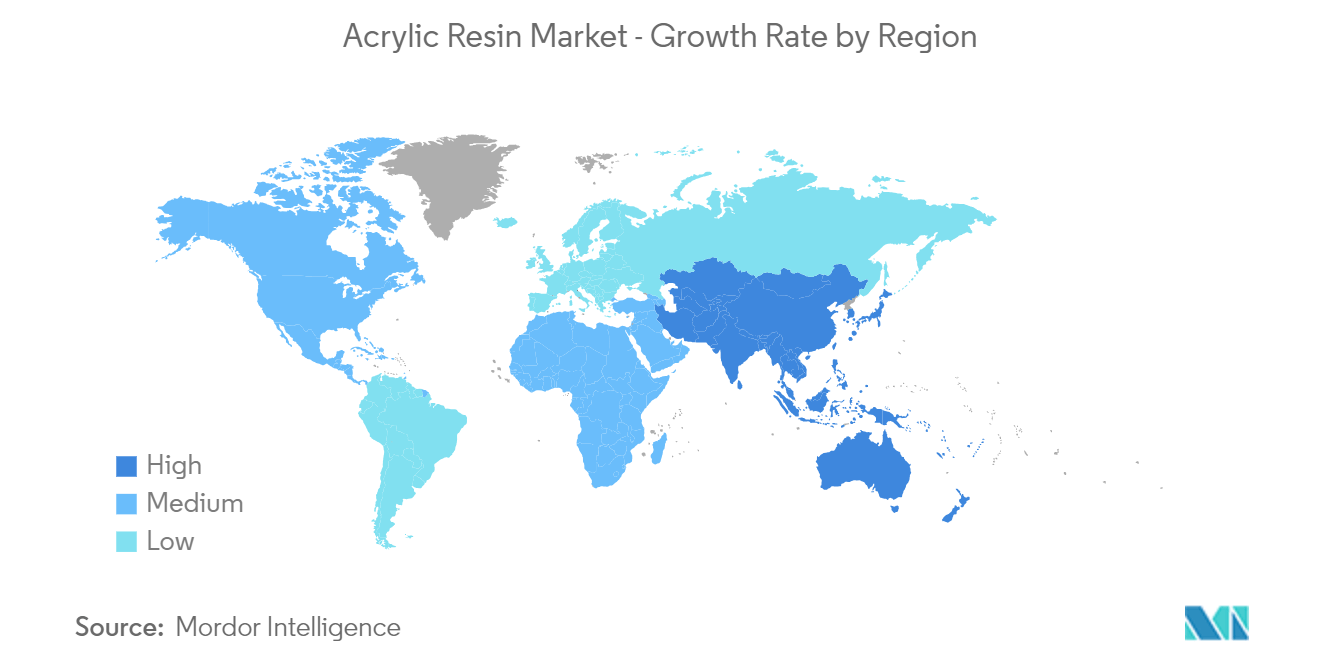
Acrylic Resin Industry Overview
The Acrylic Resin Market is partially consolidated in nature. The major players include (not in any particular order) Arkema S.A., BASF SE, Dow Chemical Company, Evonik Industries AG, and Sumitomo Chemical Company, among others.
Acrylic Resin Market Leaders
-
Arkema S.A.
-
BASF SE
-
Dow Chemical Company
-
Evonik Industries AG
-
Sumitomo Chemical Company
*Disclaimer: Major Players sorted in no particular order
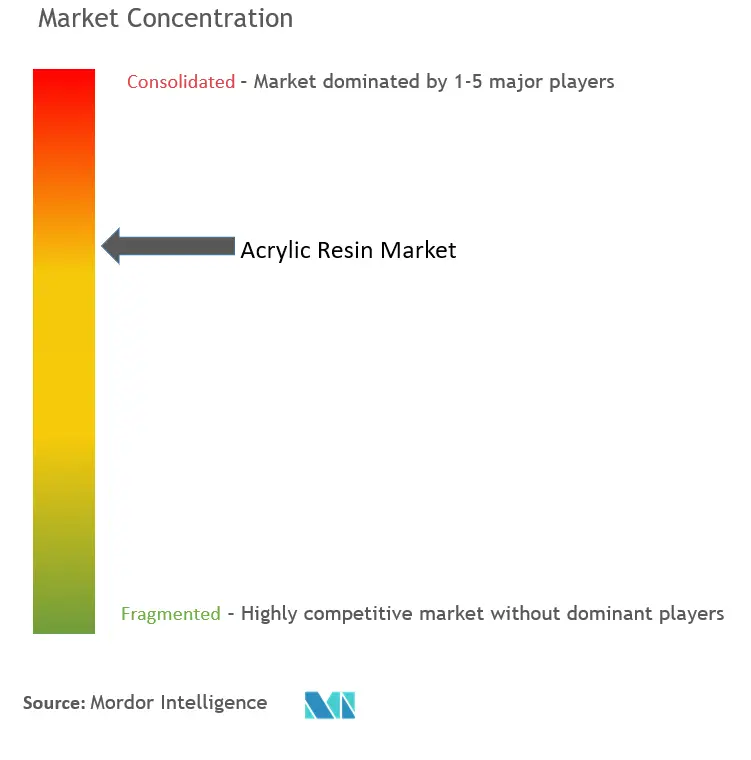
Acrylic Resin Market News
- December 2022: Sumitomo Chemical started constructing a new pilot facility for chemical recycling of acrylic resin (polymethyl methacrylate or PMMA) at its Ehime Works in Niihama City, Ehime Prefecture, Japan. The company aims to accelerate the development of a circular system for acrylic resin, from collecting used acrylic resin to recycling the collected resin into a monomer material and its use as the final product.
- November 2022: Arkema received the International Sustainability and Carbon Certification-PLUS (ISCC+) certification for a range of bio-attributed acrylic monomers and specialty acrylic additives and resins.
Acrylic Resin Market Report - Table of Contents
1. INTRODUCTION
1.1 Study Assumptions
1.2 Scope of the Study
2. RESEARCH METHODOLOGY
3. EXECUTIVE SUMMARY
4. MARKET DYNAMICS
4.1 Drivers
4.1.1 Increasing Construction and Infrastructure Activities
4.1.2 Growing Demand from the Automotive Sector
4.1.3 Other Drivers
4.2 Restraints
4.2.1 Environmental and Health Hazards Associated with Acrylic Resins
4.2.2 Other Restraints
4.3 Industry Value Chain Analysis
4.4 Porter's Five Forces Analysis
4.4.1 Bargaining Power of Suppliers
4.4.2 Bargaining Power of Buyers
4.4.3 Threat of New Entrants
4.4.4 Threat of Substitute Products and Services
4.4.5 Degree of Competition
5. MARKET SEGMENTATION (Market Size in Volume)
5.1 Product Type
5.1.1 Acrylates
5.1.2 Methacrylates
5.1.3 Hybrid
5.2 Application
5.2.1 Adhesives and Sealants
5.2.2 Paints and Coatings
5.2.3 Other Applications (Pigment Dispersion and Elastomers)
5.3 End-User Industry
5.3.1 Building and Construction
5.3.2 Automotive
5.3.3 Plastics
5.3.4 Textile and Fibers
5.3.5 Paper and Paperboard
5.3.6 Electrical and Electronics
5.3.7 Other Applications (Consumer Goods and Packaging)
5.4 Geography
5.4.1 Asia-Pacific
5.4.1.1 China
5.4.1.2 India
5.4.1.3 Japan
5.4.1.4 South Korea
5.4.1.5 Malaysia
5.4.1.6 Thailand
5.4.1.7 Indonesia
5.4.1.8 Vietnam
5.4.1.9 Rest of Asia-Pacific
5.4.2 North America
5.4.2.1 United States
5.4.2.2 Canada
5.4.2.3 Mexico
5.4.3 Europe
5.4.3.1 Germany
5.4.3.2 United Kingdom
5.4.3.3 Italy
5.4.3.4 France
5.4.3.5 Spain
5.4.3.6 Nordic
5.4.3.7 Turkey
5.4.3.8 Russia
5.4.3.9 Rest of Europe
5.4.4 South America
5.4.4.1 Brazil
5.4.4.2 Argentina
5.4.4.3 Colombia
5.4.4.4 Rest of South America
5.4.5 Middle East & Africa
5.4.5.1 Saudi Arabia
5.4.5.2 South Africa
5.4.5.3 Nigeria
5.4.5.4 Qatar
5.4.5.5 Egypt
5.4.5.6 UAE
5.4.5.7 Rest of Middle East & Africa
6. COMPETITIVE LANDSCAPE
6.1 Merger & Acquisitions, Joint Ventures, Collaborations, and Agreements
6.2 Market Share (%)**/Ranking Analysis
6.3 Strategies Adopted by Leading Players
6.4 Company Profiles
6.4.1 Arkema S.A.
6.4.2 BASF SE
6.4.3 Covestro AG
6.4.4 DIC Corporation
6.4.5 Dow Chemical Company
6.4.6 DSM
6.4.7 Evonik Industries AG
6.4.8 Henkel AG
6.4.9 Mitsubishi Chemical Corporation
6.4.10 Nippon Shokubai Kagaku Kogyo Co. Ltd.
6.4.11 Resonac Holdings Corp.
6.4.12 Sumitomo Chemical Company
- *List Not Exhaustive
7. MARKET OPPORTUNITIES AND FUTURE TRENDS
7.1 Development of Bio-based Resins
7.2 Other Opportunities
Acrylic Resin Industry Segmentation
Acrylic resin is a group of thermoplastic materials derived from acrylic acid. Acrylic resins are made from alkyl acrylates and methacrylates as homo and co-polymers and are sometimes combined with other thermoplastic monomers. Their primary application lies in paints and coatings as primary binders and as adhesives and sealants across major end-user industries like construction, automotive, electrical, and electronics, to name a few.
The Acrylic Resin Market is segmented by product type, application, end-user industry, and geography. By product type, the market is segmented into acrylates, methacrylates, and hybrid. By the application, the market is segmented into adhesives and sealants, paints and coatings, and other applications (pigment dispersion and elastomers). By end-user industry, the market is segmented into building and construction, automotive, plastics, textile and fibers, paper and paperboard, electrical and electronics, and other end-user industries (consumer goods and packaging).
The report also covers the market size and forecasts for the Acrylic Resin Market in 28 countries across five regions. For each segment, the market sizing and forecasts are done on the basis of volume (tons).
| Product Type | |
| Acrylates | |
| Methacrylates | |
| Hybrid |
| Application | |
| Adhesives and Sealants | |
| Paints and Coatings | |
| Other Applications (Pigment Dispersion and Elastomers) |
| End-User Industry | |
| Building and Construction | |
| Automotive | |
| Plastics | |
| Textile and Fibers | |
| Paper and Paperboard | |
| Electrical and Electronics | |
| Other Applications (Consumer Goods and Packaging) |
| Geography | |||||||||||
| |||||||||||
| |||||||||||
| |||||||||||
| |||||||||||
|
Acrylic Resin Market Research FAQs
How big is the Acrylic Resin Market?
The Acrylic Resin Market size is expected to reach 6.60 million tons in 2024 and grow at a CAGR of greater than 4% to reach 8.25 million tons by 2029.
What is the current Acrylic Resin Market size?
In 2024, the Acrylic Resin Market size is expected to reach 6.60 million tons.
Who are the key players in Acrylic Resin Market?
Arkema S.A., BASF SE, Dow Chemical Company, Evonik Industries AG and Sumitomo Chemical Company are the major companies operating in the Acrylic Resin Market.
Which is the fastest growing region in Acrylic Resin Market?
Asia Pacific is estimated to grow at the highest CAGR over the forecast period (2024-2029).
Which region has the biggest share in Acrylic Resin Market?
In 2024, the Asia Pacific accounts for the largest market share in Acrylic Resin Market.
What years does this Acrylic Resin Market cover, and what was the market size in 2023?
In 2023, the Acrylic Resin Market size was estimated at 6.34 million tons. The report covers the Acrylic Resin Market historical market size for years: 2019, 2020, 2021, 2022 and 2023. The report also forecasts the Acrylic Resin Market size for years: 2024, 2025, 2026, 2027, 2028 and 2029.
Acrylic Resin Industry Report
Statistics for the 2024 Acrylic Resin market share, size and revenue growth rate, created by Mordor Intelligence™ Industry Reports. Acrylic Resin analysis includes a market forecast outlook to for 2024 to 2029 and historical overview. Get a sample of this industry analysis as a free report PDF download.



